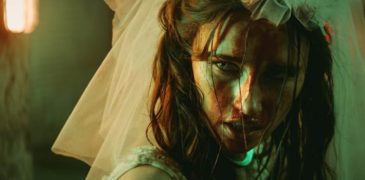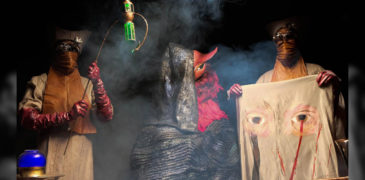
Deep Fear is a 2022 French horror, directed by Grégory Beghin, who has made a name for himself as a TV actor, Grégory made his debut behind the camera with the 2020 comedy Losers Revolution, co-directed by Thomas Ancora.
“Paris – The 1990s. Three students decide to celebrate their graduation with a visit to the local catacombs deep in the heart of the French capital. There they discover a bunker bearing the number 717. Little do they know about the legend attached to the creepy foxhole, that it was even feared by the Nazis themselves during the World War II occupation. The dugout is not the only thing the Gestapo soldiers have left behind them. Something, someone, is hunting them. And trapped deep underground in a maze of horrors, the trio needs to get out before it’s too late.” – FrightFest

The idea of World War Two Nazis surviving under the streets of Paris could have been played off as tongue-in-cheek, Deep Fear presents its story in earnest from beginning to end. Lacking any of the self-aware comedy prevalent in the “Nazi surviving until modern day” sub-genre, such as Iron Sky (2012) or Nazi’s at the Centre of the Earth (2012), the narrative is fortified with a judicious logic behind the story. Set in the undergrounds of the ’40s the story sets itself in a tangible timeframe to tell the story Grégory Beghin wants to create. However, the means of how this aspect of the story is traversed lies one of the film’s major problems.
Though paced excellently throughout the first two acts, the film decides not to focus on the story’s main facet until its final act. Occurring as a whirlwind of exposition and slow reveals, our chief antagonist only gets efficient screen time for a handful of minutes at most, leaving the principal attraction of the story as a sideshow. Undoubtedly, elongating the runtime past 80 minutes would have surely benefitted the story, allowing the necessary time to explore this atypical look at a catacomb-based horror. Instead, this incredibly interesting aspect of the story feels like wasted potential, desperately needing a deeper exploration.

Thankfully, the production proves its worth in its technical approach. Utilizing incredibly tight camera angles, the cinematography provides an excellent representation of the claustrophobic environment. The blend of tight corridors, low ceilings, and oppressive, body-sized tunnels deliver an uncomfortably enclosed and disorientating feeling that efficiently persists throughout. Additionally, the lighting, or lack thereof, compounds this feature, implementing minimal light sources through the means of characters’ flashlights reinforces the repressive atmosphere.
Consequently, this leads to certain scenes being imperceptible by design, as our protagonists stumble through the darkness with only the thin slither of their flashlights to illuminate the scene, leaving the audience in a similar scenario to our protagonists, contemplating what could lurk in the shadows beyond. This building of atmosphere is, undeniably, where Deep Fear really hits its stride and makes for a memorable experience.
Despite its shortfallings, Deep Fear is a well-crafted display of encroaching cinematography, rigid atmospheric tension as well as some impressive, though limited implementation of practical special effects. Indeed, the film is a skillful excursion into feature-length horror for Grégory Beghin, exhibiting an erudite ability to produce a disturbing ambiance. Yet, due to its faltering momentum in its third act, Deep Fear lacks reaching its full potential as a standout horror production.

We Watched Deep Fear at FrightFest 2022

Past Festival Coverage
Minore is a 2023 Greek sci-fi horror comedy, written and directed by Konstantinos Koutsoliotas, with additional writing from Elizabeth E. Schuch. Although mostly known as a visual effects artist who… The anthology film is almost as old as the industry itself. Perhaps the earliest example is D.W. Griffith’s Intolerance (1916), the director’s petulant response to wholly justified accusations of racism…. A Wounded Fawn opens with a quote from Surrealist painter and author Leonora Carrington: “I suddenly became aware that I was both mortal and touchable and that I could be… Kingdom of the Apes is a 2022 Japanese thriller, written and directed by Shūgō Fujii. Making his directorial debut with Living Hell (2000), Fujii gained notoriety with his recent mystery thriller… Pareidolia is a 2023 short horror film directed by Aaron Truss, whose previous work includes the wonderful full-length documentary Cult of VHS (2022). Amazingly, this newest project was brought to… A Descent Into Appalachian Madness “In 2023, filmmaker Aaron Irons went missing in a cave in the wilderness area known as Jeffrey’s Hell. This documentary explores the truth behind what…Minore (2023) Film Review – Greek Sci-fi Horror [FrightFest]
Midnight Peepshow (2022) Film Review | Down the Rabbit-Hole…
A Wounded Fawn (2022) Film Review – The Faun and the Muse
Kingdom of the Apes (2022) Film review – A Fable of Japanese Society
Pareidolia (2023) Review – A Short Film with Big Scare [FrigthFest]
Jeffrey’s Hell (2023) Film Review – Never Go Caving Alone! [Unnamed Footage Festival 7]

Hey there, I’m Jim and I’m located in London, UK. I am a Writer and Managing Director here at Grimoire of Horror. A lifelong love of horror and writing has led me down this rabbit hole, allowing me to meet many amazing people and experience some truly original artwork. I specialise in world cinema, manga/graphic novels, and video games but will sometime traverse into the unknown in search of adventure.
![Minore (2023) Film Review – Greek Sci-fi Horror [FrightFest]](https://www.grimoireofhorror.com/wp-content/uploads/2023/08/Minore-202310-365x180.jpg)



![Pareidolia (2023) Review – A Short Film with Big Scare [FrigthFest]](https://www.grimoireofhorror.com/wp-content/uploads/2023/08/Pareidolia-10-365x180.jpg)
![Jeffrey’s Hell (2023) Film Review – Never Go Caving Alone! [Unnamed Footage Festival 7]](https://www.grimoireofhorror.com/wp-content/uploads/2024/03/Jeffreys-hell-2024-365x180.jpg)